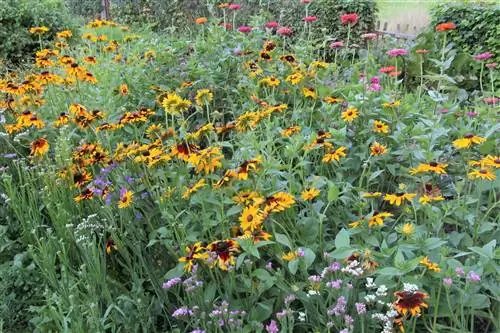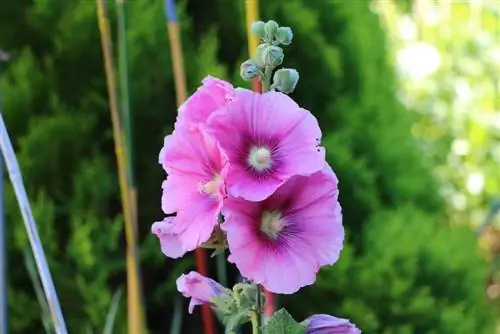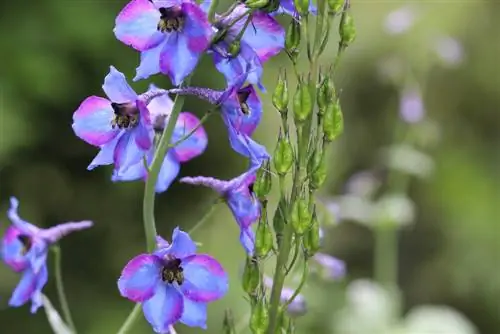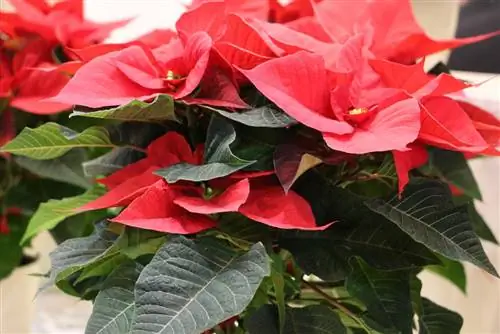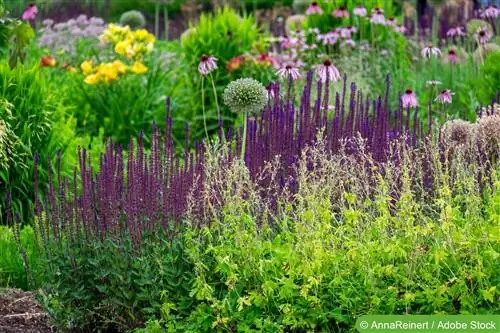- Author admin [email protected].
- Public 2023-12-17 03:39.
- Last modified 2025-01-24 12:45.
Hardy perennials as long-term bloomers in the flower bed enchant the garden with colorful flowers from early summer to autumn. They are easy to care for and magically attract butterflies, bees and the like.
Hardy perennial bloomers
Continuous bloomers are various types of flowers that produce a rich display of flowers continuously and permanently over a period of at least three months. The flowering period must occur in two consecutive seasons. Such flowering wonders can be robust perennials, but also annual or biennial flowers. Below is a small list of the most beautiful winter-hardy perennials and long-term bloomers:
From B to F
Penstemon
The magnificent cut flower is very bee-friendly. The perennial originally comes from North America and Mexico.
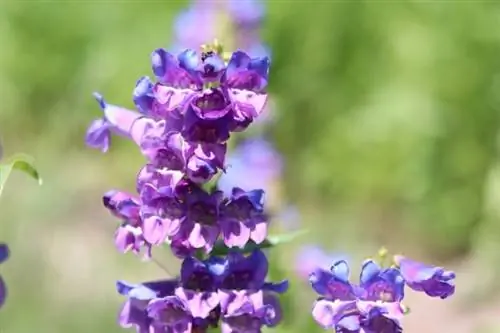
- Growth: 40 to 100 cm, upright, bushy to slightly herbaceous
- Flowering period: July to September
- Flowers: bell-shaped individual flowers in panicles; white, pink, violet, red
- Location: Sun
- Soil: permeable, fresh, rich in humus and nutrients
Blue catnip (Nepeta x faassenii)
This bee-friendly bedding perennial feels at home next to evening primrose, yarrow and Junker lily.
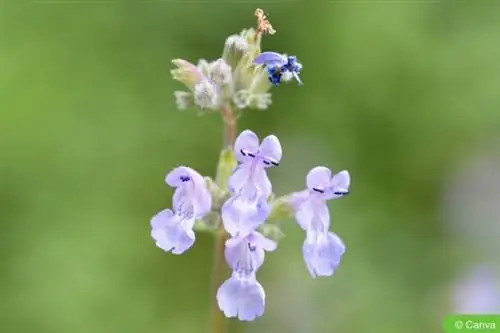
- Growth: 20 to 60 cm, upright, bushy, clump-forming
- Flowering period: May to September
- Flowers: Labiate flowers in spikes, fragrant; blue, violet
- Location: Sun
- Soil: dry to fresh, well-drained, gravelly-loamy, moderately nutrient-rich
Bush mallow (Lafathera)
This hardy perennial lives up to its name as a permanent bloomer. However, it usually only blooms for two to three years.

- Growth: 100 to 400 cm, upright, bushy
- Flowering period: July to October
- Flowers: terminal cup flowers, standing in racemes; pink, white
- Location: Sun to partial shade
- Soil: fresh to slightly moist, sandy to loamy, lime-tolerant, rich in nutrients and humus
Bertram's Sheaf (Achillea ptarmica)
The wild perennial originally comes from Eurasia. The swamp yarrow is a good cut flower and is suitable for any perennial bed.

- Growth: 30 to 100 cm, upright, clump-forming
- Flowering period: July to October
- Flowers: umbels, white
- Location: Sun to partial shade
- Soil: slightly moist, gravelly to clayey, calcareous, moderately nutrient-rich
Tip:
Pruning after flowering promotes re-blooming.
Scented Nettle (Agastache)
Typical for this plant is the smell of anise and fennel when the leaves are crushed.
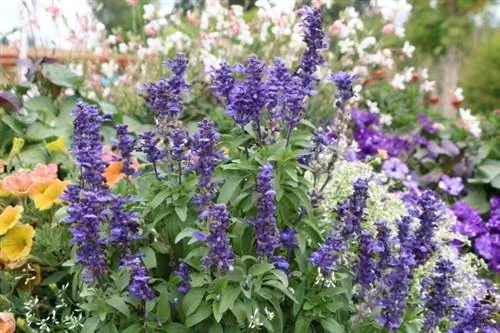
- Growth: 30 to 250 cm, bushy, upright, clump-forming
- Flowering period: June to September
- Flowers: dense false spikes; white, blue, pink, red, orange
- Location: Sun
- Soil: permeable, dry, calcareous, loamy-sandy
Flame Flower (Phlox)
This fragrant cut flower is the classic among cottage garden plants. The strength of the scent depends on the temperature, it is particularly strong at midday or in the evening.
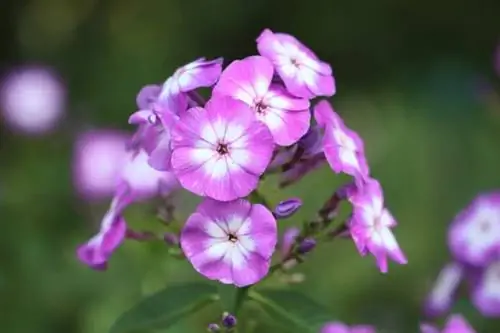
- Growth: 100 to 120 cm, clumpy, bushy, upright
- Flowering period: July to September
- Flowers: in panicles; white, pink, red, pink, blue, violet
- Location: Sun to partial shade
- Soil: fresh to moist, permeable, rich in humus and nutrients
From G to K
Large-flowered garden daisy (Leucanthemum x superbum)
Planted in larger groups of three to five, this radiant cut flower sets accents in any perennial bed.

- Growth: 50 to 70 cm, loosely clumpy, upright
- Flowering period: May to September
- Flowers: single terminal flowers, large-flowered, radiating, white, light yellow
- Location: Sun
- Soil: permeable, fresh, loamy, rich in nutrients and humus
Large-flowered girl's eye (Coreopsis grandiflora)
The hardy perennial, which comes from the dry forests and prairies of North America, feels particularly at home as a permanent bloomer in natural steppe and prairie gardens next to blue bellflowers and purple delphiniums.
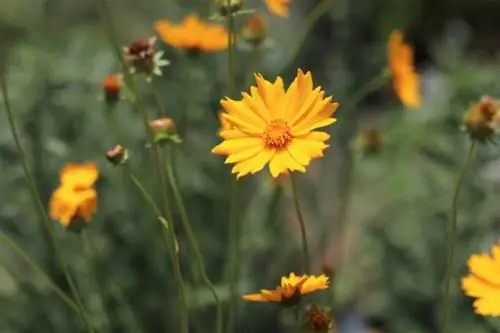
- Growth: 40 to 80 cm, clump-forming, upright
- Flowering period: June to October
- Flowers: single flowers, basket flowers, yellow
- Location: Sun
- Soil: moderately dry to moist, permeable, sandy-loamy, rich in humus and nutrients
Astrantia major
The star umbel is a definite favorite for cottage gardens or natural gardens. It sets special accents in small groups with ornamental grasses.

- Growth: 50 to 70 cm, upright, bushy, clump-forming
- Flowering period: June to August
- Flowers: terminal, single flowers in umbels, red, white, pink
- Location: sunny to partially shaded
- Soil: fresh to moderately moist, calcareous, permeable, sunny-loamy, rich in nutrients and humus
Iceland poppy (Papaver nudicaule)
This lovely perennial with its flowers that shine from a distance is native to the subarctic regions of Iceland, the USA and Canada.
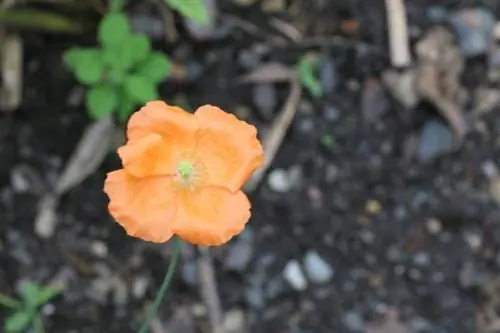
- Growth: 30 to 50 cm, upright, clump-forming
- Flowering period: May to August
- Flowers: single, terminal cup flowers, light yellow, white, orange, red
- Location: sunny to slightly sunny
- Soil: dry to fresh, stony to sandy-loamy, permeable, low in humus and nutrients
Note:
All parts of the plant contain a poisonous milky sap.
Cockade flower (Gaillardia)
This flower, originally from the dry steppes and grasslands of North and South America, is a splash of color in every garden.
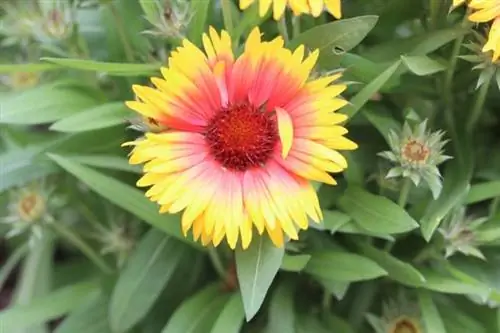
- Growth: 15 to 75 cm, bushy, upright
- Flowering period: July to October
- Flowers: terminal, plate-shaped individual flowers, yellow, orange, red, multicolored
- Location: Sun
- Soil: moderately dry to fresh, gravelly to sandy, lime-loving, rich in nutrients and humus
Tip:
In autumn, pruning should be done just above the ground to encourage flowering the following year.
Globe thistle (Echinops ritro)
After flowering, the spherical flowers develop into beautiful seed heads that are suitable for drying.
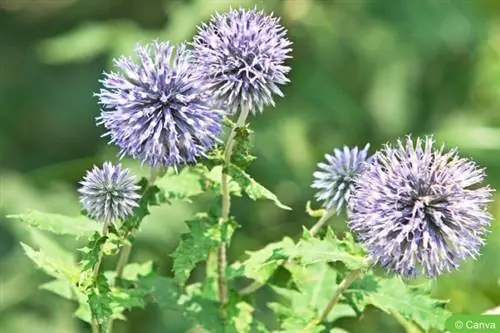
- Growth: 60 to 100 cm, basal tuft of leaves, upright, clumpy
- Flowering period: July to October
- Flowers: ball-shaped, light blue, blue to violet-blue
- Location: Sun
- Soil: dry to slightly moist, well-drained, gravelly-loamy, rich in humus, moderately nutrient-rich
From O to R
Oxtongue (Anchusa officinalis)
This wild perennial is particularly suitable for planting in natural gardens, in perennial beds, on the edge of trees and gravel beds.
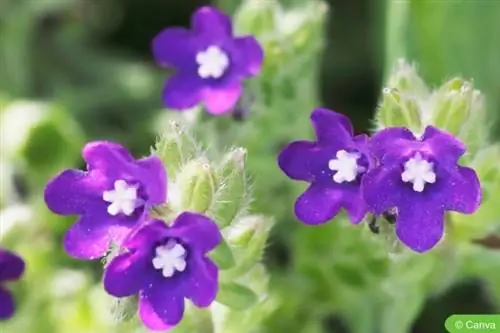
- Growth: 40 to 130 cm, upright, clumpy
- Flowering period: June to September
- Flowers: cup-shaped individual flowers, violet, red
- Location: Sun
- Soil: dry to slightly moist, well-drained, nutrient-rich, sandy-loamy
Magnificent candle (Gaura lindheimeri)
The individual flowers of this easy-care perennial bloomer only open for one day. The perennial is a good companion for roses.
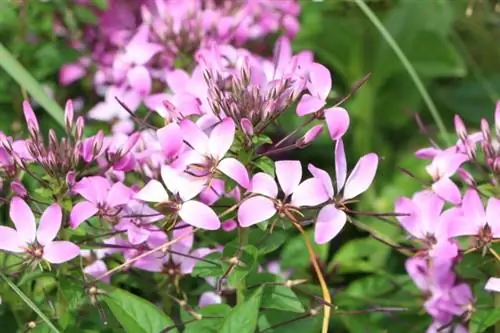
- Growth: 80 to 150 cm, clump-forming, bushy, upright
- Flowering period: June to October
- Flowers: simple cup flowers, hanging in loose clusters, white, pink
- Location: sunny, sheltered from the wind
- Soil: permeable, dry, gravelly-sandy, low in humus and nutrients
Purple Coneflower (Echinacea purpurea)
This popular garden perennial is also known as red coneflower or hedgehog's head and is originally from the prairies of North America.
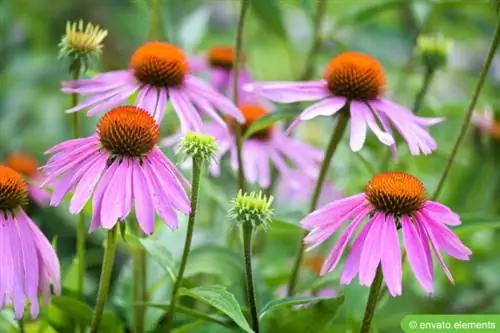
- Growth: 80 to 100 cm, upright, bushy, clump-forming
- Flowering period: July to September
- Flowers: double, unfilled, flower heads, slightly scented
- Flower color: yellow, orange, red, white
- Location: Sun to light partial shade
- Soil: moderately dry to moist, gravelly to sandy, rich in humus and nutrients
Delphinium (Delphinium)
Characteristic of this perennial bloomer is the backward-facing spur on the back of each flower of the hardy perennial.
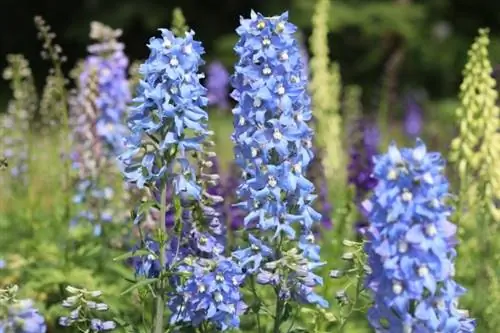
- Growth: 120 to 180 cm, clumpy, upright
- Flowering period: June to September
- Flowers: double, unfilled, in clusters
- Flower color: light blue, blue-violet, white, pink, yellow
- Location: Sun
- Soil: permeable, fresh to slightly moist, sandy-loamy, nutrient-rich
With S
Yarrow (Achillea)
This native perennial is an excellent bee pasture and fits perfectly into natural gardens.
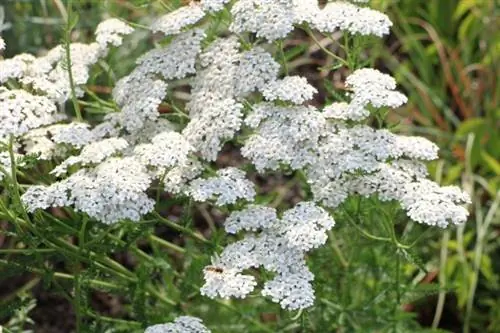
- Growth: 40 to 60 cm, upright, bushy, clump-forming
- Flowering period: June to October
- Flowers: flat umbels
- Flower color: yellow, white, red
- Location: Sun
- Soil: permeable, fresh to moist, rich in humus and nutrients, loamy-sandy
Scabiosa (Scabiosa)
This long-lasting cut flower magically attracts butterflies and bees.
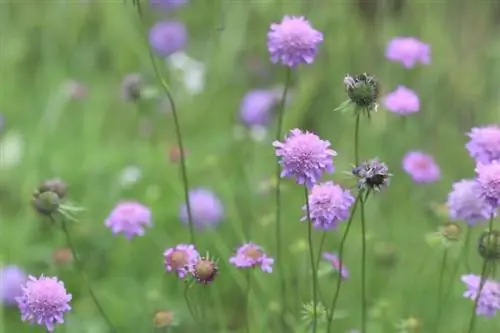
- Growth: 60 to 80 cm, upright, clump-forming
- Flowering period: June to October
- Flowers: single terminal flowers, plate-shaped
- Flower color: violet, blue, white, red
- Location: Sun
- Soil: permeable, fresh, rich in humus and nutrients, sandy-loamy
Suneye (Heliopsis)
This undemanding perennial looks particularly good in combination with medium-sized grasses, phlox and asters.
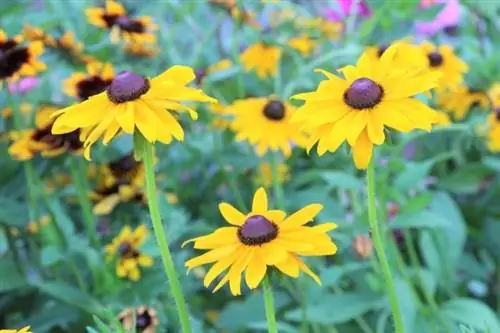
- Growth: 60 to 170 cm, upright, bushy, clump-forming
- Flowering period: July to October
- Flowers: densely packed individual flower heads
- Flower color: yellow, orange
- Location: Sun to partial shade
- Soil: dry to fresh, calcareous, nutrient-rich, loamy-sandy
Sun Bride (Helenium)
This distinctive summer flower is the ideal companion for roses and ornamental grasses.

- Growth: 100 to 120 cm, upright, clumpy
- Flowering period: June to October
- Flowers: basket-flowered corymbs
- Flower color: yellow, red, orange, reddish brown
- Location: Sun
- Soil: permeable, fresh, loamy-sandy, rich in humus and nutrients
Hollyhock (Alcea rosea)
This hardy perennial fits perfectly into nostalgic gardens as a permanent bloomer when accompanied by smaller colored perennials.
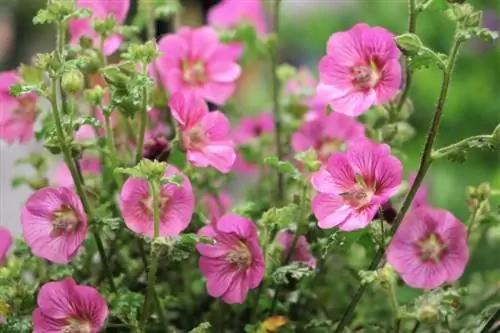
- Growth: 180 to 250 cm, upright, clump-forming
- Flowering period: June to September
- Flowers: double, unfilled, cup-shaped individual flowers
- Flower color: red, orange, violet, yellow, pink, white
- Location: sunny to sunny
- Soil: dry to moderately moist, well-drained, gravelly-loamy, rich in humus and nutrients
Spurflower (Centranthus)
This easy-care and adaptable hardy perennial is the perfect companion for lady's mantle, cranesbill and lavender.
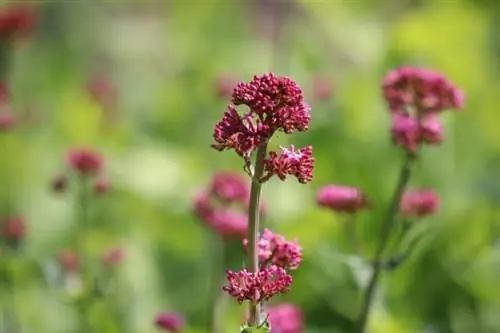
- Growth: 60 to 80 cm high, clumpy, upright
- Flowering period: April to October
- Flowers: small umbels, standing in panicles
- Flower color: white, red
- Location: Sun
- Soil: dry to fresh, calcareous, stony-sandy, low in humus and nutrients, pH value 6.0 to 8.0
Frequently asked questions
How can the flowering period of the permanent bloomers be extended?
All spent flowers should be plucked or cut off regularly. This stimulates the formation of new flowers. It is also advisable to cut off spent perennials close to the ground as soon as possible. Followed by top dressing and regular watering. After a few weeks, new shoots and flower formation occur.
Do hardy perennials need additional winter protection?
Usually winter protection is not absolutely necessary as they pull in their above-ground shoots in autumn. The overwintering buds are usually protected in the ground. However, perennials, especially in harsh areas, should also receive winter protection with a layer of leaves or pine branches. This provides protection against temperature fluctuations and at the same time prevents frost damage if budding occurs early.

